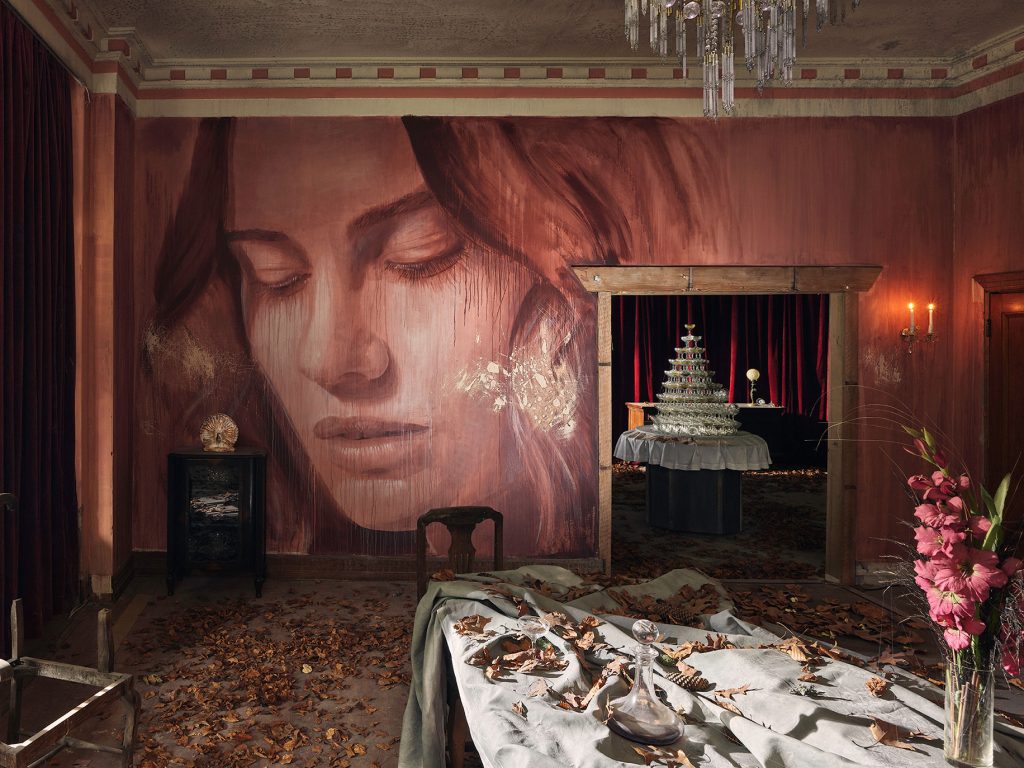There’s something inexplicably powerful about Empire – an art installation project that has transformed the 1930s Dandenong Ranges mansion Burnham Beeches into a living, breathing arts organism of gigantic creative proportion. The project also combines an elaborate music soundtrack, lighting design and a series of botanical installations that aid in the delivery of a beautifully beastly work.
Developed over a course of a year, the project features both ‘pretty’ and sombre images of female faces painted by Melbourne artist Tyrone ‘Rone’ Wright. These softly meld into the dilapidated state of the property – discoloured, crumbling, rotting, faded and dank. The images colour the spaces which carry a strong sense of nostalgic, melancholic edge. Framing the images throughout the property is the extensive and simply brilliant interior Art-Deco styling of Carly Spooner – a genius in her own right, whose skills have made the rooms sing with reverence; but for what or for whom we might never know – but that’s not important. Across 12 previously empty spaces within the estate, Empire becomes a dreamscape that does a darn fine job of connecting with our souls.
The property’s grand-scale (former) glamour is everywhere to be seen: twisting wrought iron balustrades, Deco archways, custom chandeliers, crown mouldings and ornate ceilings – all evident of the home’s illustrious past. There’s a level of historic wonder here that’s filmset fanatically fun – a bit like exploring an un-sunk Titanic; and cleverly, Spooner’s layered styling touches bring depth and further historic relevance to the installation. Dried grasses and wildflowers sprout from sofas and floorboards; autumn leaves from ages past lie waiting. Books, old radios, sheet music and a broken-down bakelite telephone rest strewn and forgotten – almost as though the night’s wildlife: possums and other creatures have played their part over a list of chaotic evenings. The grand dining room has a feel as cold and lonesome as the wide open spaces of the winter lodge in Stanley Kubrick’s The Shining; and although it’s simply not appropriate to touch, I’m desperately wanting to lift a silver-service meat platter lid to reveal a possible food rot beneath, or wipe the dust from a platter, leaving a clean coarsely polished finger line.
Burnham Beeches was built as a private residence, completed in 1933 – it’s the work of Australian architect Harry Norris, designer of the Melbourne CBD icons the Nicholas Building and Curtin House. Over the years the property has had a range of purposes: a post World War II children’s hospital, a country club, a medical research facility, and in the 80s it was a luxury hotel. In 2010 Shannon Bennett’s Vue Group and developer Adam Garrison purchased the property with future plans of redeveloping the mansion, but for now we gain perhaps a more constructively different insight – the gift of nostalgia. ‘It’s delicate, but potent.’
Rone says that fragments of inspiration for Empire came from the heart-wrenching melancholia of Johnny Cash’s acclaimed Mark Romanek-directed film clip Hurt – (where Cash covered Nine Inch Nails) he was careful not to dictate the narrative.
‘I want people to walk in and feel like they can explore the possibilities of what might or might not have happened here,’ Rone explains. ‘I love exploring the concept of how – and why – something so magnificent can be left to decline into ruin. Empire is about offering audiences the chance to create their own story; to temporarily transport their minds to another place, another time.’
Rone Empire – at Burnham Beeches
Rone’s Empire will be open to the public from March 6 and run until April 22, 2019 at Burnham Beeches, Sherbrooke.
Book now at: www.r-o-n-e.com



Comments are closed.